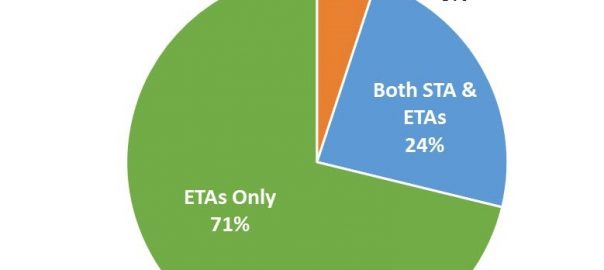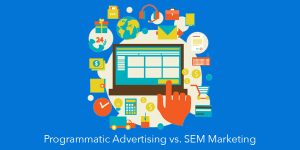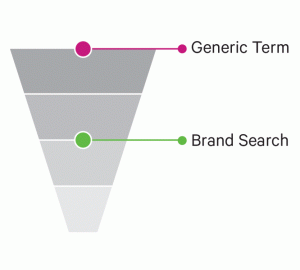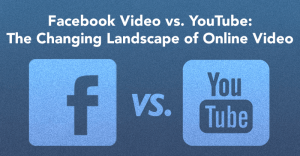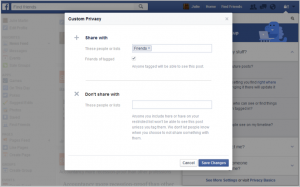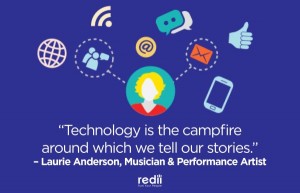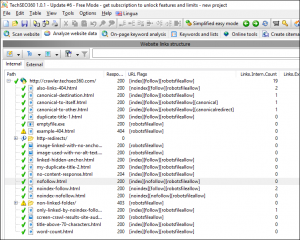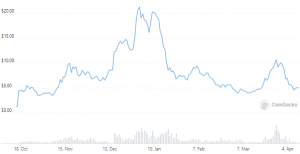— September 12, 2017
I’ve got good news and bad news. In traditional fashion, let’s start with the bad news.
By almost every metric, businesses with big budgets are doing better in Google AdWords than lower spenders. Maybe not surprising, but it still hurts. The rich get richer while us little guys get left in the dust.
How do we know? We looked at 18,037 reports from our AdWords Performance Grader and compared performance between advertisers spending more than $ 50K a month and everyone else. And big spenders really came out ahead.
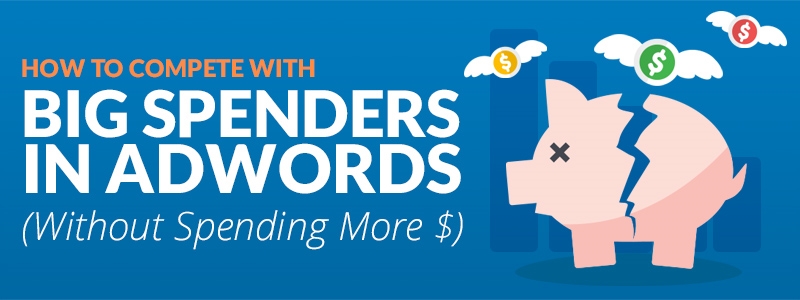
But wait! Don’t leave in despair just yet. The truth is, you can emulate a lot of what those bigger advertisers with deeper pockets are doing, without spending more money. In AdWords, success is often just a matter of getting more active and actually doing more stuff in your account! This is your good news.
Big spenders know this because there’s so much money on the line, they can’t afford to mess around. They can’t half-ass it or leave their account untouched for a month. Instead, they stay on top of their performance and make optimizations every week.
You can do that too – and get WAY better results, without just pouring more budget into your account.
In this article, we’ll show you the top nine things that big AdWords spenders are doing that you’re not, so you can compete with the big guys even on a smaller budget.
#1. Big Spenders ALWAYS Use Conversion Tracking
We think it’s crazy that anyone spending money in AdWords wouldn’t enable conversion tracking, but it does happen.
Not to big spenders though.
Fully 100% of advertisers spending more than $ 50K per month have conversion tracking on. Because OF COURSE they do!
If you’re not seeing your conversion volume creep up and to the right, how on Earth can you be expected to optimize for success? A 75% CTR sounds great, but if you can’t tie all those clicks back to conversions, you’re burning cash.
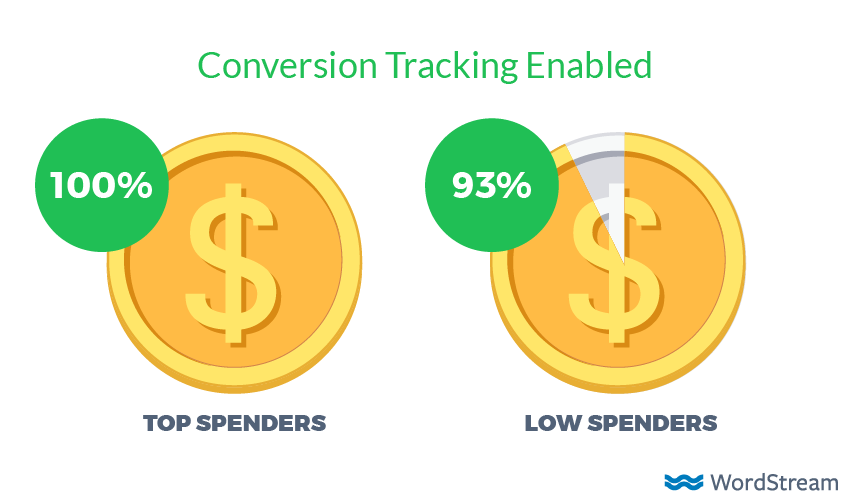
Luckily, most advertisers realize they need to track conversions in some fashion, and that’s reflected in our data. Only 7% of the lower spenders don’t have conversion tracking enabled. But there’s no reason both numbers couldn’t be 100%.
Even if you’re spending less money on AdWords than Coca-Cola, you should care about ROI.
Getting conversion tracking set up on your website is relatively simple and completely free (unless you need a developer’s assistance, in which case it’ll cost you a bit but it’s still more than worth it)! That $ 500 or $ 10,000 or however much you’re spending on AdWords ads each month can significantly impact your business. Learning how and why is paramount to your success in AdWords. That starts with conversion tracking.
#2. Big Spenders Have More Landing Pages
Even with conversion tracking enabled and a structurally sound account in place, there’s a factor outside of AdWords that can have a profound impact on performance. I’m talking about those action-inducing corners of your website to which you send paid traffic. I’m talking, of course, about landing pages.
Big-budget advertisers know that if you have multiple ads and multiple offers, you need multiple landing pages too. That’s because your prospects will respond much better to specific, tailored messaging that matches the ad they clicked very closely. If you’re sending all your traffic to one generic landing page (or worse, your home page!) they’re going to get confused and bounce.
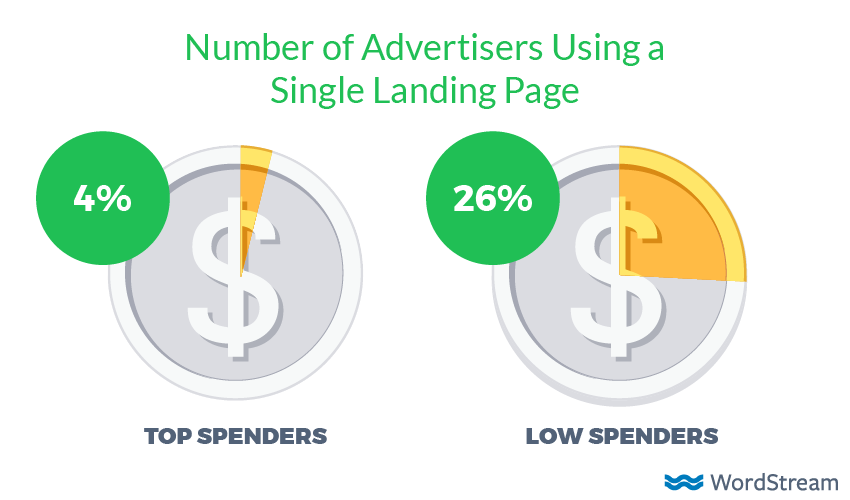
More than 1 in 4 (26%) of lower-budget AdWords accounts only have a single active landing page, compared to just 4% of top-spending accounts.
You need to fix this!
We know the challenge here. When you’re small, you don’t have a fleet of designers and developers at the ready to build new landing pages at the drop of a hat.
But at the very least, you can duplicate your current design and begin testing images and copy. If your AdWords campaigns are built out logically and you’re currently using a single landing page across your whole account, make a duplicate version for each campaign.
This will allow you to optimize the language on each page for the subset of keywords you’re bidding on, improving relevance for both the user and the Quality Score algorithm (in an ideal world, you can do this ad the ad group level. But hey, I know you’re busy).
Regardless of which direction you take your landing page testing in, make sure there’s more than one! If you need any more proof that this is crucial to compete with the big guys, take a look at our next graph…
#3. On Average, Big Spenders Have a 17% Higher Conversion Rate
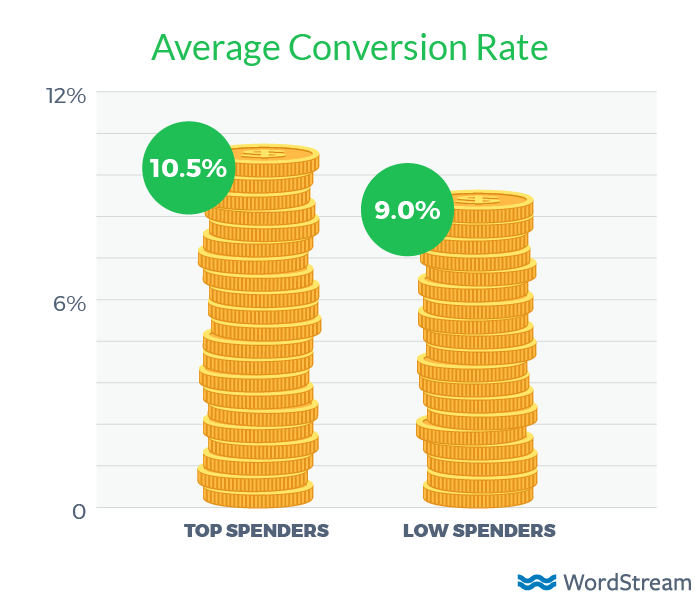
The average click-to-conversion rate of our top-spender accounts is 10.5%; in lower-spending accounts, the average conversion rate is 9.0%.
That may not sound like a big difference, but it means the money guys are getting 17% more conversions out of the same number of clicks, without having to spend more for more clicks.
How are they doing it?
Well, see above. Part of the reason that big spenders have more landing pages is because they prioritize conversion rate optimization.
When you start considering CRO, it’s tempting to skip right to your landing pages (if you have more than one!) and start fiddling with button colors and graphic elements. Don’t do that. Or, rather, do that later. But start at the beginning.
Make sure the keywords you’re bidding on relate to your business. Broad terms might bring in a ton of traffic, but paying for superfluous clicks is a waste of your budget. We recommend allocating more than half of your budget to high-intent, top-converting keywords.
You also need to make sure that the offers you’re pointing people to are truly compelling. A better offer can raise your conversion rates much more than a better button.
Once it comes time to address your landing pages, your goal should be to ensure a positive, useful, and speedy experience for visitors. You can do this by:
- Writing compelling headlines (just like your ads!)
- Using concise, targeted body copy
- Testing to uncover the most eye-catching, enticing CTA for your offer
- Designing a user-friendly form (making the journey from ad to purchase as frictionless as possible)
- A fast-loading, mobile-friendly design
- Advanced class: Try to affect your readers on an emotional level
It should come as no surprise that everything you can do to bolster conversion rates in your account has already been mentioned elsewhere in this post. It’s as if a small, focused subset of account activity yields the best possible return on your time and bottom line.
Who’d have thought…
Now, let’s remember that before conversion rates even come into play, searchers need to click on your ads in the first place. Well, big spenders have you beat there too…
#4. Top Spenders Have 38% Higher Click-Through Rates
We’ve often extolled the virtues of optimizing for clickability. Having a super-high CTR ultimately means that your ads are appealing to your prospects, and Google loves that.
Getting complete strangers to click on your ads is part art, part science. As you may have guessed, top-spenders tend to nail both sides of the CTR coin.
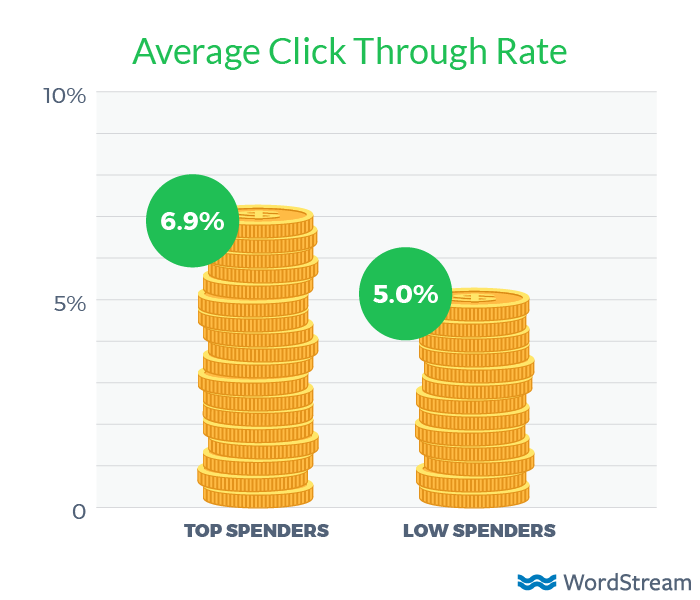
Top-spending AdWords accounts have an average CTR of almost 7%, whereas low spenders have an average CTR of 5%.That’s a 38% difference, a chasm in a world where a few measly percentage points can mean the difference between profitability and boarding your doors.
So how are the big guys doing it? The truth is, bidding more isn’t going to make your ads more clickable. The ads at the top of the SERP are generally the ones with the highest Quality Scores, which correlates highly with relevance and better-than-expected click-through rate. If your ads really resonate with users, you can get high CTR even if you’re bidding less than bigger advertisers!
If you’re not spending tons of dough in AdWords, you can compete with the big guys by spending more time on your ad copy, and by getting creative.
Most people don’t read past the headline; thanks to expanded text ads, AdWords now gives you two of them to work with. By improving relevance (leveraging your target keyword) and including a call to action in one of your headlines, you can improve your CTRs without having to crack your piggy bank open.
#5. Big Spenders Are Using More Ad Extensions (4,631% More)
What if I told you there’s an extremely easy, totally FREE way to raise the CTR of your ads without even having to get creative?
That method is ad extensions.
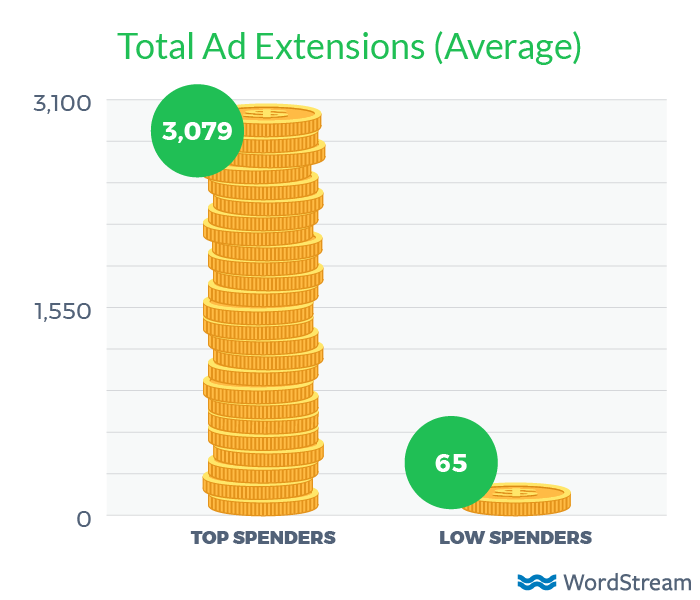
Where top-spenders have an average of 31 ad extensions for every text ad in their accounts, low-spenders tend to operate at a one-to-one ratio.
Framed another way, there were 4,631% more ad extensions in the set of 450 top-spending accounts we analyzed than in the 17,587 low-spending accounts.
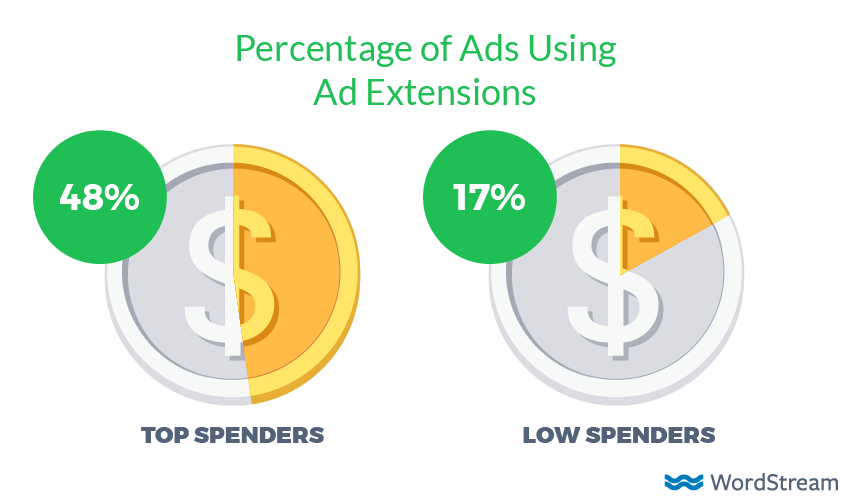
Further, top spenders have extensions enabled on about half of their ads (48%), while the lower spenders only have extensions enabled on 17% of their ads, leaving 83% of their ads extensionless.
Yikes.
When it comes to PPC ads, size matters, and these top spenders know that you can use every ad extension in the book to make your Expanded Text Ads big enough to blot out the sun (or at least the rest of the SERP).
Provided your ads are served in the top three positions, there are a dozen extensions you can use to increase both value and ad real estate (and that doesn’t even include the automated extensions Google’s wont to sling your way just because it’s a Wednesday afternoon).
We get it. If you’re a one-man-band, routine optimization and writing ads is time-consuming enough; worrying about optional ad extensions probably feels like a waste of time.
I assure you, it isn’t.
Depending which one’s served, ad extensions have the chance to improve your CTR six-fold. Why? Because in concert with the additional value and information they provide your prospects, ad extensions also push your competitor’s ads and organic listing further down the SERP; if there’s only one gas station in town, that’s where everybody’s going to fuel up.
Now, if what you just read has inspired you to open another browser and add more ad extensions to your own AdWords account, do me this one favor: apply them to every campaign!
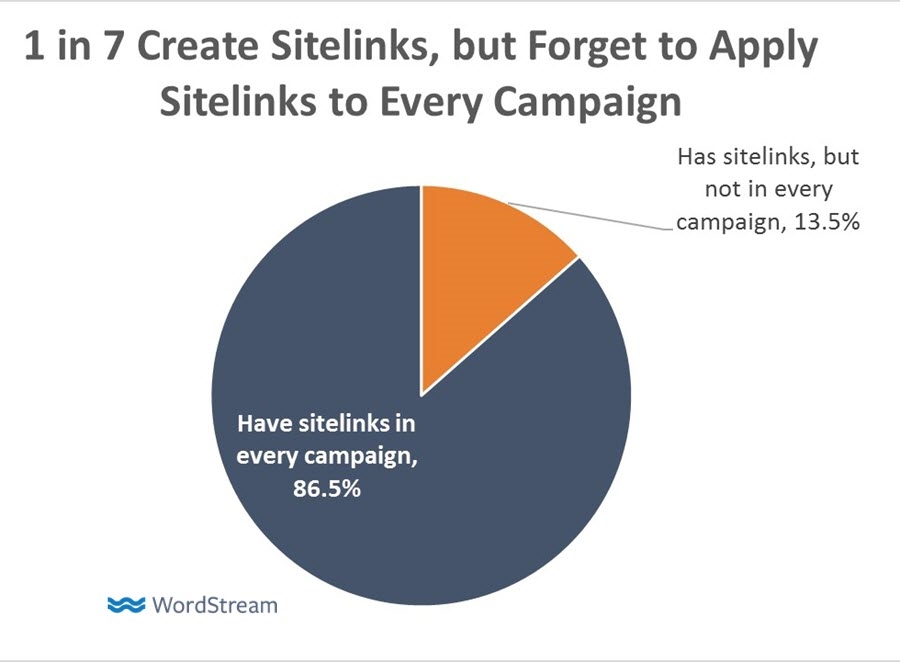
Per WordStream’s own Mark Irvine, 13.5% of AdWords accounts don’t have their sitelink extensions applied to every campaign. If this is the case for the hyper-valuable sitelink extension, I can only imagine it’s the same—if not worse— for the rest of ‘em.
Ad extensions get people to notice your ad faster, and even if they don’t drive direct clicks, you’ll certainly notice more clicks on the main headline when an ad extension is showing; take a page out of the big boys’ playbook and implement them today!
#6. Big Spenders Add (a Lot) More Negative Keywords
Negative keywords are the offensive line of any high-functioning AdWords account: you know they’re there, but you only really think about them when something’s their fault.
If you’re bidding on the perfect keywords (high intent! relevant! volumetrically salient!) but you can’t seem to earn a conversion to save your life, it’s probably not because your prospects don’t like you. Provided you’re tracking conversions, it’s likely that either…
- A lack of negative keywords is causing a deluge of superfluous impressions, many of which are stealing budget away from those interested in your offer
- Overzealous negative keywords are impeding your ability to enter auctions for relevant search queries
If you operate with a lean marketing budget, I’m willing to wager that it’s the former. Why?
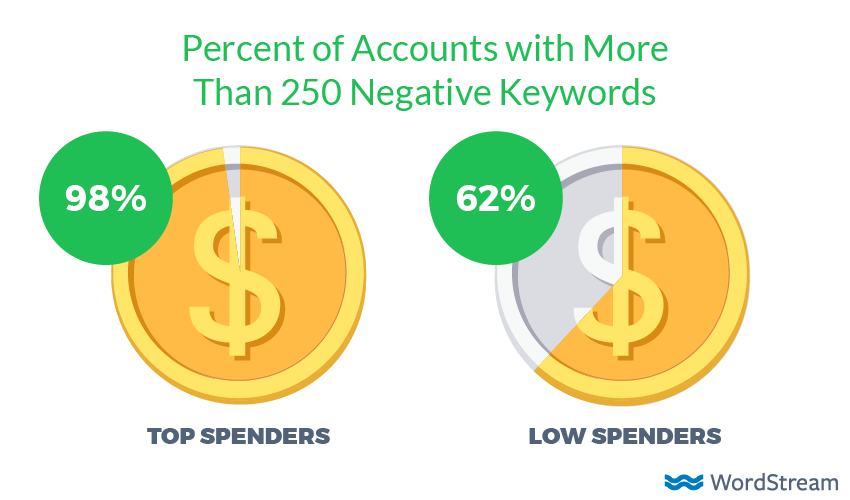
Because 8% of low-spending AdWords accounts have no negative keywords at all, and 62% have less than 250; 98% of top-spending accounts have more than 250 negative keywords.
Let’s say you sell crocodile loafers and you’re bidding on the keyword +men’s +shoes. How many of these terms do you want to serve ads for?
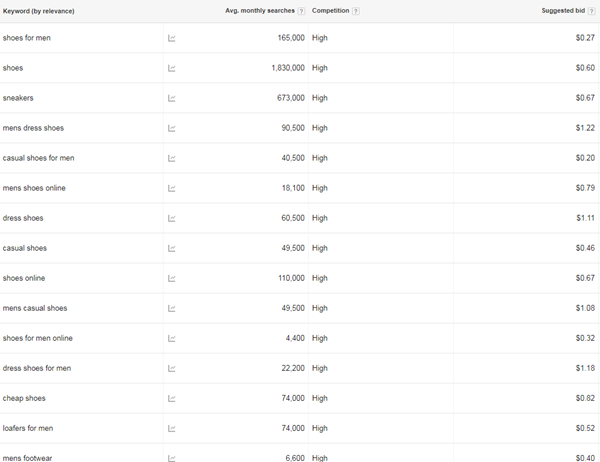
Many of them are simply too broad to justify paying for (see: “shoes”). Others may be off-brand (“sneakers” or “cheap shoes”). Paired with the sky-high monthly search volume on some of these, you’d be out of budget before you could blink.
Large advertisers have already figured this out, and devote a little time each week to reviewing their search query reports, between visits to the Ping-Pong table and chocolate fountain.
For the rest of us, by simply jumping into the search terms report available in AdWords, filtering out terms that converted, and sorting by impressions, we’re able to discern whether a search query is making us money or costing us money. While doing so, it’s well worth the little extra elbow grease to add negative keywords frequently if you want to maximize your ad spend.
(P.S. Note that shuffling this process a bit and filtering explicitly for converting search queries can be a greatway to uncover new keywords for your account.)
#7. Big Spenders Have 1,448% More Expanded Text Ads
Per the illustrious Mark Irvine (again – useful guy), wholesale expanded text ad (ETA) adoption across AdWords accounts (regardless of size and monthly spend) is at 71%; better still, a mere 5% of advertisers are completely stuck in the past, subsisting on the vastly inferior standard text ad format alone.
Advertisers, rejoice!
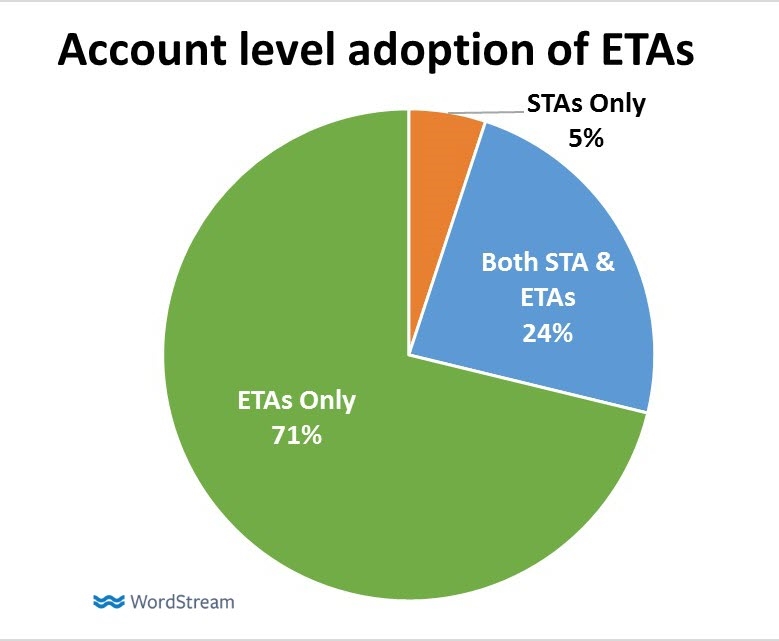
Hold that thought.
Our new research indicates that, when we look at ETA adoption in high-spend vs. low-spend accounts, the disparity is far greater. In fact, there were 1,448% more Expanded Text Ads in top-spending accounts than their lower-spending counterparts.
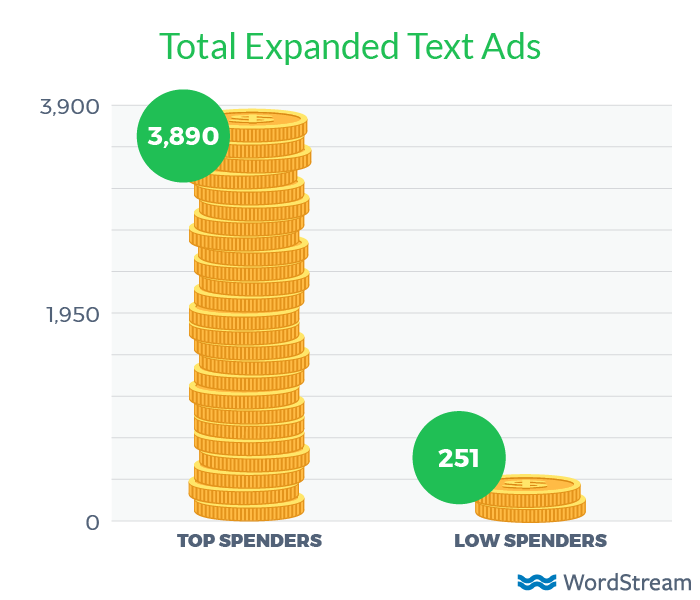
When ETA’s first came on the scene, pausing standard text ads and replacing them completely was considered passé. As such, many advertisers opted to rotate their top performing standard ad against a new ETA. When the STA inevitably outperformed the ETA (thanks, historical data!), advertisers paused the big, shiny ETA . Hell, we did this in our own account: Why ostensibly waste ad spend?
These tests were misleading, though. Really misleading. Eventually, those still leaning on shorter ads are going to be left in the dust. If maximizing SERP real estate with ad extensions is recommended, doing so with your ad copy alone should be required.
As usual, the disparity probably stems from larger advertisers having the resources to continue testing new ads and smaller advertisers, well, not. While top-spenders have spent the better part of a year replacing old ads with new ones and removing even top-performing standard ads from their ad rotation, smaller advertisers are lagging behind.
The solution? Simple.
Taker everything you’ve learned from this post so far and use it to roll out a wave of killer Expanded Text Ads. Like most of our advice here, it won’t cost you anything but a little effort. The big boys on the SERP won’t know what hit ‘em.
#8. High Spenders Have Higher Quality Scores
Once upon a time, there was a unicorn-loving digital marketing personality who believed in the value of Quality Score above all. His name was Larry. Maybe you’re familiar with him?
Our founder’s obsession with Quality Score is understandable. I mean, it’s a valuable metric that, despite countless think pieces, is still shrouded in secrecy. What we do know about QS is that it can significantly impact your CPC.
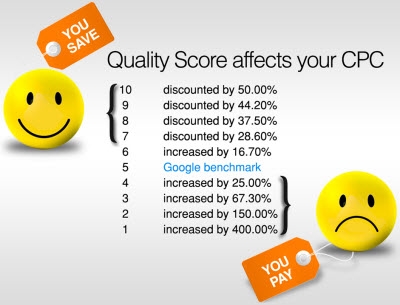
As you can see, Quality Score can drastically raise or reduce your average CPC.
A perfect Quality Score can discount your CPC by about 50%; a heinous Quality Score can increase costs by 400%. At that point, you’re either bidding on the wrong keywords or there’s some serious work to be done on your ads and landing pages.
Anyway…
Impression-weighted Quality Score is a variation on the QS metric that’s available to you in AdWords. The difference is straightforward: it adjusts for the number of impressions (shocking, I know), giving you some much needed context. Impression-weighted Quality score isn’t a KPI, per se, but it is an indicator of health. Like an AdWords thermometer.
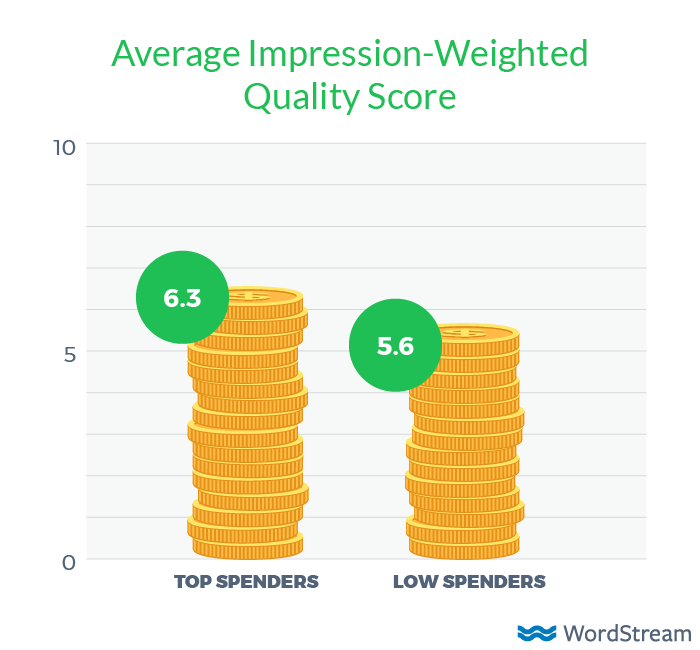
According to our new research, top-spenders have an average impression-weighted Quality Score of 6.3, where low-spenders average just 5.6.
That 12% difference might not sound like much, but in reality, it represents unneeded budget inefficiency that small businesses simply cannot sustain. If you’ve got a lower budget, you need to do everything in your power to make sure you’re spending it efficiently.
To determine the impression-weighted Quality Score of a given ad group or campaign use the following formula:
(Impressions * Quality Score) / Impressions
Once you’ve got a handle on your impression-weighted Quality Score, it’s time to pull some levers to improve it. The factors that impact Quality Score the most are:
- That all-important CTR
- Ad relevance
- Landing page experience
These should all look familiar.
Again, improving ad copy and landing page quality are the most direct ways to close the gap between the average joe and the multi-national conglomerate (at least when it comes to AdWords).
#9. Big Spenders Take More Actions in Their Accounts
If you’re not familiar with the AdWords Performance Grader, here’s a little primer: It’s a free tool that runs a quick audit on your AdWords account, checking for many of the best practices outlined above (Quality Score, negative keywords, account activity, etc.) and gives you an overall grade based on your performance.
The Grader also checks for account activity, because in our experience, strong performance correlates highly with doing stuff – logging into your account and making adjustments for improvement. If you don’t even look at your account for weeks at a time, how are you going to improve anything?
Unsurprisingly, we found that the $ 50K-and-up crowd aren’t just spending more money in their accounts; they’re also spending more time there. Check it out:
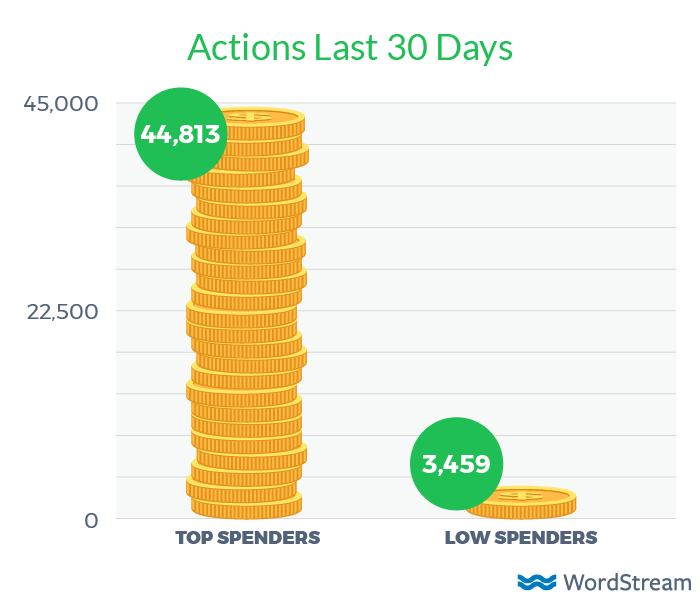
The big spenders group is WAY more active – 1196% more active. They’re getting in there and actually doing all the stuff we talked about above.
What Does It All Mean?
Money can’t buy happiness and it can’t buy you a perfect AdWords account.
However, with great budgets comes great responsibility. Businesses that spend a lot on their online advertising take their account performance very seriously, so they invest time and attention in their accounts, not just money.
Even if you can’t raise your budget significantly, you can make like a big spender and commit to more activity in your account: adding new keywords and negative keywords, testing new ads, building dedicated landing pages, enabling every ad extension under the sun.
We promise, if you spend a month or two working diligently on your account, without spending a penny more, you’ll see your own AdWords Grader score go up too.
Data Sources
We pulled all the data collected from AdWords Performance Grader reports in the last quarter (Q2 2017), excluding duplicate reports from users who had previously run a report and users with $ 0 in spend. We separately analyzed accounts spending $ 50,000 per month and up, and accounts spending $ 1-$ 49,999 per month. We only looked at advertisers bidding in USD, AUD, CAD, EUR and ZAR.
Thanks to Meg Lister, Kate Lindsay, and Elisa Gabbert for their work on this group effort.
Digital & Social Articles on Business 2 Community
(71)
Report Post